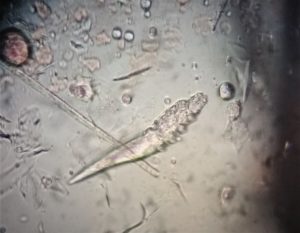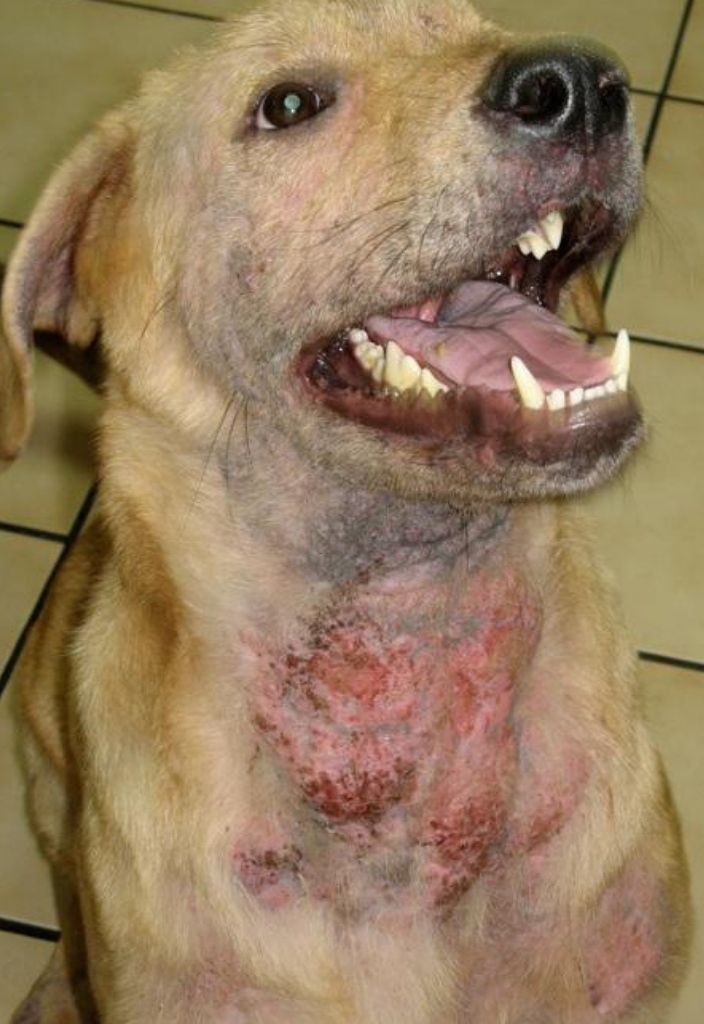dermatitis relief

free shipping over $100 (USA & Canada)
1-877-937-4372 the pet expert hotline

Vet-Formulated Supplement of Medicinal Mushrooms for Dogs


If your cat or dog is experiencing hair loss, itching, crusts, malodorous skin, and is generally miserably uncomfortable, it could be mange. The first thing we do diagnostically when presented with a skin condition in a dog or cat is a skin scrape test and look at the debris under the microscope. With a skin scraping, along with a tape test and ringworm culture we can rule in or out mange. In our experience, most animals with mange, whether it be sarcoptic or demodectic, have secondary bacterial infections.

Scabies are a highly contagious mite that is easily transmitted between pets and to humans as well.
There are several types of mange in dogs and cats. In dogs, sarcoptic mange or demodectic mange are the two main mange mites. Sarcoptic mange (also called scabies) lives burrowed in the skin and causes itching, redness, and crusts on the tips of the ears, elbows, hocks, and chest and belly. It is sometimes difficult to find by skin scraping but it fits the clinical picture, treatment is recommended in lieu of finding the mite on the microscope. It is a highly contagious mite that is easily transmitted between pets and to humans as well. If you have red itchy bumps on your skin, you should consult your physician. Fortunately, the mites can only survive a short time off the dog in the environment. Cleaning your pets’ environment well and throwing out bedding is recommended. There are several ways to treat sarcoptic mange, but the main treatments are anti-parasitic medications along with addressing and treating any secondary infections.

Demodectic mange in dogs is caused by a mange mite most commonly Demodex canis. Unlike sarcoptic mange, demodectic mange is not considered a contagious disease. These mites live inside hair follicles, and classically, Demodex mites have been felt to only be transferable from mother to newborn pup. That said, Demodex is a normal resident of dog skin in very small populations; it is only in some individual dogs that mites cause problems. Immunosuppressed, stressed, malnourished or dogs with other underlying metabolic or endocrine abnormalities are more susceptible to Demodex infections.
There are three forms in which treatment and severity differ. The first is localized. Localized Demodex is the least severe and treated generally with supporting the immune system and oral medication. Treatment for localized Demodex has a much better prognosis than generalized.

Generalized demodicosis has a hereditary component, usually occurs in adults, and is much more difficult to treat. In these cases, searching for an underlying reason for the immunosuppression such as underlying metabolic or endocrine disease is necessary for a full recovery. Treatment involves addressing the underlying cause and supporting the immune system as well as treating secondary infections. There are several flea products that kill the mite, your veterinarian will choose the most appropriate. Lastly and less commonly is demodectic pododermatitis – mange confined to the paws. Bacterial infections commonly accompany this and all Demodex infections. This form of Demodex is very tough to cure and may take months of treatment and therapy.
Mange in cats is less common, in my experience, and is due to similar underlying reasons as in dogs. The two main mange mites are notoedric mites (feline scabies) and demodectic mites. As in dogs, sarcoptic mange is contagious, and demodectic mange is not. Both mites are diagnosed in the same manner as dog mites by a skin scrape and have similar symptoms and secondary infections in cats. Sarcoptic mange is treated most easily and effectively with certain anti-flea medications as well. Demodex however, is more difficult to get rid of and oftentimes requires medicated dips which are not fun for all involved. Antiparasitic medications can be curative in some cases.
Treatment of mites with antiparasitic medication in both dogs and cats involves treating secondary skin infections, balanced, wholesome nutrition, supporting the immune system with supplements. To combat mites, we recommend NHV Nature’s Immuno, NHV PetOmega 3, NHV Multi Essentials, NHV Stimmune, and NHV Ouch Away Spray for topical use.
If you suspect your pet may be suffering from a mite infection, see your veterinarian and contact our Pet Experts to discuss which supplements may be right for your pet.
dermatitis relief

Holistic Support for Dermatitis, Mange and Yeast Infections
buy 2 and save $3
Your furkiddo’s skin can be sensitive to things like environmental allergies, biting insects, fungal overgrowth and much more! To self-soothe, your pup may start to bite, lick, or scratch themselves causing inflammation and possible hair loss. NHV Ouch Away, dog skin infection spray, helps your pup get on top of skin and coat issues naturally.


Your furkiddo’s skin can be sensitive to things like environmental allergies, biting insects, fungal overgrowth and much more! To self-soothe, your pup may start to bite, lick, or scratch themselves causing inflammation and possible hair loss. NHV Ouch Away, dog skin infection spray, helps your pup get on top of skin and coat issues naturally.

Natural Support for Dermatitis, Mange and Skin Infections
Your pup's skin is their largest organ! And because of this, their skin is constantly susceptible to infection, airborne irritants, icky biting insects and much more. Your furkiddo will scratch and bite when they are feeling stressed and have ouchies on their body. This obsessive behavior can introduce unwanted bacteria, whether it is from the environment or your pup’s own body, which can lead to infection. An itchy, inflamed ‘dog hot spot’ can be the end result. If these dog hot spots are left untreated, they can progress to secondary skin infections, abscesses or even metastatic tumors (eg. carcinoma). Ouch Away spray, dog skin infection spray, helps heal inflamed, itchy skin and promotes hair regrowth.
How NHV's Dog Skin Infection Spray Relieves Irritated Skin
Since your pup’s skin is their largest organ, it probably doesn't surprise you that skin issues are the most common health concern in dogs. These include (but are not limited to) dermatitis, mange and skin infections.
Dermatitis in dogs is a hypersensitivity or allergic reaction to a variety of common and typically harmless environmental substances. These allergens include grasses, pollens, house dust mites, or mold spores. Breeds predisposed to developing allergies include Chinese Shar-Peis, Wire Fox Terriers, Golden Retrievers, Dalmatians, Boxers, Boston Terriers, Labrador Retrievers, Lhasa Apsos, Scottish Terriers, Shih Tzus, and West Highland White Terriers. However, any breed (purebred or mixed) can be susceptible to allergies. The areas most affected are generally the paws, face, ears, front legs, and abdomen, but scratching all over the body is fairly common too. Ouch Away Spray for dog skin infections, contains ingredients like Chamomile, Marigold and Aloe vera that cools and soothes wounds, burns and irritated skin while strengthening the immune system.
The most common signs of dermatitis in dogs are:
Dog mange is caused by mites and can lead to inflamed skin and nasty sores. Scabies or sarcoptic mange is contagious and is transmissible to humans. Black mange is not transmissible to humans due to it being a genetic condition. Secondary bacterial and yeast infections may develop if left untreated while sores on the skin can build up and release a powerful musty odor. You can learn more about mange and how to help your dog if they are suffering from it in Dr. Cook's article on mange. Ingredients like Rosemary, Tea Tree oil and Lemongrass oil, within the Ouch Away Spray, are effective topically against external parasites, combating skin infections and helping to stimulate fur regrowth (from constant biting and scratching).
Help Support Your Dog Naturally
NHV Ouch Away Spray, dog skin infection spray, is an effective topical spray that is 100% natural and vet-formulated to soothe your pup’s skin, coat issues, and dog hot spots. To learn more about what causes dog hot spots and how to help your furry friend, read our vet talk or watch our video about skin infections. Get in touch with an NHV pet expert if you have any questions or concerns about skin and coat health - we are always here to help!
Made with the finest, organically grown, or ethically harvested herbs. Made specifically for pets, vet-formulated and vet approved.
How to Administer
Topical Spray: Spray several times a day to affected area until healed. It may some times be necessary to shave or trim your pet’s hair so that the Ouch Away spray reaches the affected area. If necessary, cover the affected area with gauze dressing.
Caution
Do not spray near or into eyes or nose. May initially sting on an open cut. A vet examination prior to use of this product is recommended. If your pet’s condition does not improve or deteriorates consult your vet and stop the use of the product.
Information presented by NHV Natural Pet Products is for educational purposes only.
Natural Support for Dermatitis, Mange and Skin Infections
Your pup's skin is their largest organ! And because of this, their skin is constantly susceptible to infection, airborne irritants, icky biting insects and much more. Your furkiddo will scratch and bite when they are feeling stressed and have ouchies on their body. This obsessive behavior can introduce unwanted bacteria, whether it is from the environment or your pup’s own body, which can lead to infection. An itchy, inflamed ‘dog hot spot’ can be the end result. If these dog hot spots are left untreated, they can progress to secondary skin infections, abscesses or even metastatic tumors (eg. carcinoma). Ouch Away spray, dog skin infection spray, helps heal inflamed, itchy skin and promotes hair regrowth.
How NHV's Dog Skin Infection Spray Relieves Irritated Skin
Since your pup’s skin is their largest organ, it probably doesn't surprise you that skin issues are the most common health concern in dogs. These include (but are not limited to) dermatitis, mange and skin infections.
Dermatitis in dogs is a hypersensitivity or allergic reaction to a variety of common and typically harmless environmental substances. These allergens include grasses, pollens, house dust mites, or mold spores. Breeds predisposed to developing allergies include Chinese Shar-Peis, Wire Fox Terriers, Golden Retrievers, Dalmatians, Boxers, Boston Terriers, Labrador Retrievers, Lhasa Apsos, Scottish Terriers, Shih Tzus, and West Highland White Terriers. However, any breed (purebred or mixed) can be susceptible to allergies. The areas most affected are generally the paws, face, ears, front legs, and abdomen, but scratching all over the body is fairly common too. Ouch Away Spray for dog skin infections, contains ingredients like Chamomile, Marigold and Aloe vera that cools and soothes wounds, burns and irritated skin while strengthening the immune system.
The most common signs of dermatitis in dogs are:
Dog mange is caused by mites and can lead to inflamed skin and nasty sores. Scabies or sarcoptic mange is contagious and is transmissible to humans. Black mange is not transmissible to humans due to it being a genetic condition. Secondary bacterial and yeast infections may develop if left untreated while sores on the skin can build up and release a powerful musty odor. You can learn more about mange and how to help your dog if they are suffering from it in Dr. Cook's article on mange. Ingredients like Rosemary, Tea Tree oil and Lemongrass oil, within the Ouch Away Spray, are effective topically against external parasites, combating skin infections and helping to stimulate fur regrowth (from constant biting and scratching).
Help Support Your Dog Naturally
NHV Ouch Away Spray, dog skin infection spray, is an effective topical spray that is 100% natural and vet-formulated to soothe your pup’s skin, coat issues, and dog hot spots. To learn more about what causes dog hot spots and how to help your furry friend, read our vet talk or watch our video about skin infections. Get in touch with an NHV pet expert if you have any questions or concerns about skin and coat health - we are always here to help!
Made with the finest, organically grown, or ethically harvested herbs. Made specifically for pets, vet-formulated and vet approved.
How to Administer
Topical Spray: Spray several times a day to affected area until healed. It may some times be necessary to shave or trim your pet’s hair so that the Ouch Away spray reaches the affected area. If necessary, cover the affected area with gauze dressing.
Caution
Do not spray near or into eyes or nose. May initially sting on an open cut. A vet examination prior to use of this product is recommended. If your pet’s condition does not improve or deteriorates consult your vet and stop the use of the product.
Information presented by NHV Natural Pet Products is for educational purposes only.
overall vitality

For Overall Health and Well-Being
buy 2 and save $3
Support your dog’s health with omega 3 fish oil for dogs. Help them maintain a healthy coat, eyes, joints, immune system and overall organ function.


Support your dog’s health with omega 3 fish oil for dogs. Help them maintain a healthy coat, eyes, joints, immune system and overall organ function.

Our omega 3 fish oil for dogs is a great source of EPA (Eicosapentaenoic Acid 600mg) and DHA (Docosahexaenoic acid 460mg) essential fatty acids. This fish oil supplement for dogs is derived from sardines, anchovies and North Atlantic cod liver oil. It is molecularly distilled and cold pressed to improve the bioavailability of the omega 3 fatty acids, and is medical and human grade quality.
Omega 3 fish oil for dogs may be beneficial for the following:
Processed pet foods have increased omega-6 fatty acids, and decreased omega-3 fatty acids. The University of Maryland Medical Center states, "It is very important to maintain a balance between omega-3 and omega-6 fatty acids in the diet. A proper balance helps maintain and even improve health." Your dog’s body cannot easily make essential fatty acids. It is vital to provide omega 3 fish oil for dogs as an added supplement to your pet’s daily diet.
The American Journal of Veterinary Medicine has published studies on the benefits of omega 3 fatty acids (fish oils) for arthritis and degenerative joint disease in dogs. The studies showed that dogs who were given omega 3 fatty acids had a significantly improved ability to get up from a resting position and marked improvement in walking ability.

Suggested Dosage: To be taken once per day. Add to food based on weight chart.
Therapeutic Dosage: Double the quantity for maximum period of 4 weeks or follow veterinarian advise.
Pet’s Weight Dosage
0-15 lb = ¼ tsp
15-30 lb = ½ tsp
30-60 lb = 1 tsp
60-90 lb = 1 ½ tsp
How to Administer: Shake well before use. The easiest method is to add the dosage to your pets food. Some pets can be finicky, if this occurs consider hiding the appropriate amount in food most pet’s love such as fish, chicken, yogurt, or a favorite treat. If your pet only eats dry food then soak kibbles at feeding time.
For Best Results
Dietary supplements are beneficial to the health and well-being of your pet and are safe for long-term use. Every pet responds to natural supplements differently, therefore it is important to be consistent and administer the product daily. Supplements generally take two to four weeks to take effect, however this will vary from one animal to the next.
Product Storage
All NHV Natural Pet Products contain no artificial additives, preservatives or coloring. Shelf life after opening is 6 months and must be refrigerated after opening.
Cautions and Contraindications
Avoid During Pregnancy.
Our omega 3 fish oil for dogs is a great source of EPA (Eicosapentaenoic Acid 600mg) and DHA (Docosahexaenoic acid 460mg) essential fatty acids. This fish oil supplement for dogs is derived from sardines, anchovies and North Atlantic cod liver oil. It is molecularly distilled and cold pressed to improve the bioavailability of the omega 3 fatty acids, and is medical and human grade quality.
Omega 3 fish oil for dogs may be beneficial for the following:
Processed pet foods have increased omega-6 fatty acids, and decreased omega-3 fatty acids. The University of Maryland Medical Center states, "It is very important to maintain a balance between omega-3 and omega-6 fatty acids in the diet. A proper balance helps maintain and even improve health." Your dog’s body cannot easily make essential fatty acids. It is vital to provide omega 3 fish oil for dogs as an added supplement to your pet’s daily diet.
The American Journal of Veterinary Medicine has published studies on the benefits of omega 3 fatty acids (fish oils) for arthritis and degenerative joint disease in dogs. The studies showed that dogs who were given omega 3 fatty acids had a significantly improved ability to get up from a resting position and marked improvement in walking ability.

Suggested Dosage: To be taken once per day. Add to food based on weight chart.
Therapeutic Dosage: Double the quantity for maximum period of 4 weeks or follow veterinarian advise.
Pet’s Weight Dosage
0-15 lb = ¼ tsp
15-30 lb = ½ tsp
30-60 lb = 1 tsp
60-90 lb = 1 ½ tsp
How to Administer: Shake well before use. The easiest method is to add the dosage to your pets food. Some pets can be finicky, if this occurs consider hiding the appropriate amount in food most pet’s love such as fish, chicken, yogurt, or a favorite treat. If your pet only eats dry food then soak kibbles at feeding time.
For Best Results
Dietary supplements are beneficial to the health and well-being of your pet and are safe for long-term use. Every pet responds to natural supplements differently, therefore it is important to be consistent and administer the product daily. Supplements generally take two to four weeks to take effect, however this will vary from one animal to the next.
Product Storage
All NHV Natural Pet Products contain no artificial additives, preservatives or coloring. Shelf life after opening is 6 months and must be refrigerated after opening.
Cautions and Contraindications
Avoid During Pregnancy.
immune & allergy support

Natural Dog Food Allergy Supplement and Immune Support.
buy 2 and save $3
3 month supply for a small to medium size
Soothes food allergies, skin allergies (dermatitis), and infection. Helps relieve a variety of symptoms related to allergies. Supports a healthy balance of the immune system in pets with conditions such as autoimmune disease.

Soothes food allergies, skin allergies (dermatitis), and infection. Helps relieve a variety of symptoms related to allergies. Supports a healthy balance of the immune system in pets with conditions such as autoimmune disease.
Stimmune helps balance the immune system and helps ease allergy symptoms that can make your dog miserable. Stimmune is an all-natural, vet-formulated dog allergy immune supplement that will help your pet deal with dog food allergies as well as other immune related disorders.
Stimmune can provide dog allergy help with allergic reactions related to food, as well as environmental allergies including reactions to fleas, insect bites, food and other environmental factors. For more acute seasonal or environmental allergies, please try Alge-Ex for a remedy specifically formulated for your dog.
An allergy is an overreaction of the immune system to a normally harmless substance called an antigen. Allergies in dogs often occur when allergens are inhaled, ingested, or absorbed by the body. When this occurs, the immune system becomes over-reactive to substances it believes are harmful. This reaction causes a release of histamine, causing the common allergy symptoms in your pet.
The cause of allergies in dogs can be difficult to determine. While it is always best to eliminate the cause altogether, like omitting a specific food from their diet, some causes can be nearly impossible to totally eradicate, like dust mites or pollen. This is where a dog allergy supplement that is taken daily can help relieve your loved one of common allergens, even when you're not exactly sure what they are allergic to.
Dog food allergy support is close at hand with Stimmune added into your pet’s daily regimen. This 100% natural herbal supplement was formulated by a holistic veterinarian to comprehensively care for your pet’s health.
Explore our Pet Expert Q&A to ask questions about your pet’s allergic reactions or view questions that other concerned pet owners like you have posted. Or, visit our blog to learn how to prevent food allergies in dogs and cats.

Astragalus – Stimulates liver function and helps balance the immune system. High in antioxidants it also helps protect against oxidative damage.
Echinacea Purpurea – Reduces inflammation, helps boost the immune system and efficiently fights infection.
Oregon Grape – Has antibiotic, anti-inflammatory and immunostimulatory properties.
Asian Ginseng – Has been used for thousands of years to help against various health issues. This antioxidant herb helps balance the immune system, helps the body fight infections and helps the body cope against stress.
Myrrh – An astringent that relieves irritated skin, Myrrh is high in anti-inflammatory and antioxidant effects.
Select your pet's weight to determine the correct dose.
To be taken twice daily. Determine your pet’s weight and then use the easy chart below to determine the correct dose. This is the minimum dosage.
Pet's Weight Dosage
0 - 15 lb = 0.5 ml
16 - 30 lb = 1.0 ml
31 - 45 lb = 1.5 ml
46 - 60 lb = 2.0 ml
61 - 75 lb = 2.5 ml
Over 75 lb = 3.0 ml
For small animals (rabbits, ferrets), avians and reptiles use 1 drop for every 2 lb of body weight.
How to Administer
Shake well before use. The easiest method is to use the dropper provide and places the drops into your pet’s food or favorite treat. You can also use the dropper and squirt directly into the pet’s mouth.
Some pets can be finicky, if this occurs consider hiding the drops in foods most pet’s love such as fish, chicken or yogurt or a favorite treat. If your pet only eats dry food then soak a few kibbles at feeding time.
For Best Results
Herbal dietary supplements are beneficial to the health and wellbeing of your pet and are safe for long-term use. Every pet responds to natural herbal supplements differently, therefore it is important to be consistent and administer the product daily. Supplements generally take two to four weeks to take effect, however this will vary from one animal to the next.
Product Storage
All NHV Natural Pet Products are pure herbal extracts and contain no artificial additives, preservatives or coloring. Shelf life after opening is 6 months and must be refrigerated after opening.
Cautions and Contraindications
Do not use Stimmune in pregnant or nursing animals. Speak to your vet before using our products. A second visit is recommended if your pet’s condition does not improve, or deteriorates after continued use of the supplements.
All information provided by NHV Natural Pet Products is for educational purposes only.
Stimmune helps balance the immune system and helps ease allergy symptoms that can make your dog miserable. Stimmune is an all-natural, vet-formulated dog allergy immune supplement that will help your pet deal with dog food allergies as well as other immune related disorders.
Stimmune can provide dog allergy help with allergic reactions related to food, as well as environmental allergies including reactions to fleas, insect bites, food and other environmental factors. For more acute seasonal or environmental allergies, please try Alge-Ex for a remedy specifically formulated for your dog.
An allergy is an overreaction of the immune system to a normally harmless substance called an antigen. Allergies in dogs often occur when allergens are inhaled, ingested, or absorbed by the body. When this occurs, the immune system becomes over-reactive to substances it believes are harmful. This reaction causes a release of histamine, causing the common allergy symptoms in your pet.
The cause of allergies in dogs can be difficult to determine. While it is always best to eliminate the cause altogether, like omitting a specific food from their diet, some causes can be nearly impossible to totally eradicate, like dust mites or pollen. This is where a dog allergy supplement that is taken daily can help relieve your loved one of common allergens, even when you're not exactly sure what they are allergic to.
Dog food allergy support is close at hand with Stimmune added into your pet’s daily regimen. This 100% natural herbal supplement was formulated by a holistic veterinarian to comprehensively care for your pet’s health.
Explore our Pet Expert Q&A to ask questions about your pet’s allergic reactions or view questions that other concerned pet owners like you have posted. Or, visit our blog to learn how to prevent food allergies in dogs and cats.

Astragalus – Stimulates liver function and helps balance the immune system. High in antioxidants it also helps protect against oxidative damage.
Echinacea Purpurea – Reduces inflammation, helps boost the immune system and efficiently fights infection.
Oregon Grape – Has antibiotic, anti-inflammatory and immunostimulatory properties.
Asian Ginseng – Has been used for thousands of years to help against various health issues. This antioxidant herb helps balance the immune system, helps the body fight infections and helps the body cope against stress.
Myrrh – An astringent that relieves irritated skin, Myrrh is high in anti-inflammatory and antioxidant effects.
Select your pet's weight to determine the correct dose.
To be taken twice daily. Determine your pet’s weight and then use the easy chart below to determine the correct dose. This is the minimum dosage.
Pet's Weight Dosage
0 - 15 lb = 0.5 ml
16 - 30 lb = 1.0 ml
31 - 45 lb = 1.5 ml
46 - 60 lb = 2.0 ml
61 - 75 lb = 2.5 ml
Over 75 lb = 3.0 ml
For small animals (rabbits, ferrets), avians and reptiles use 1 drop for every 2 lb of body weight.
How to Administer
Shake well before use. The easiest method is to use the dropper provide and places the drops into your pet’s food or favorite treat. You can also use the dropper and squirt directly into the pet’s mouth.
Some pets can be finicky, if this occurs consider hiding the drops in foods most pet’s love such as fish, chicken or yogurt or a favorite treat. If your pet only eats dry food then soak a few kibbles at feeding time.
For Best Results
Herbal dietary supplements are beneficial to the health and wellbeing of your pet and are safe for long-term use. Every pet responds to natural herbal supplements differently, therefore it is important to be consistent and administer the product daily. Supplements generally take two to four weeks to take effect, however this will vary from one animal to the next.
Product Storage
All NHV Natural Pet Products are pure herbal extracts and contain no artificial additives, preservatives or coloring. Shelf life after opening is 6 months and must be refrigerated after opening.
Cautions and Contraindications
Do not use Stimmune in pregnant or nursing animals. Speak to your vet before using our products. A second visit is recommended if your pet’s condition does not improve, or deteriorates after continued use of the supplements.
All information provided by NHV Natural Pet Products is for educational purposes only.
Published: October 26, 2018